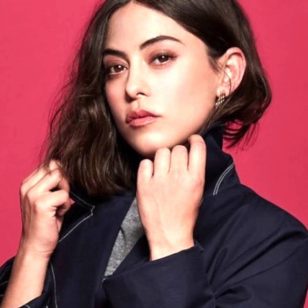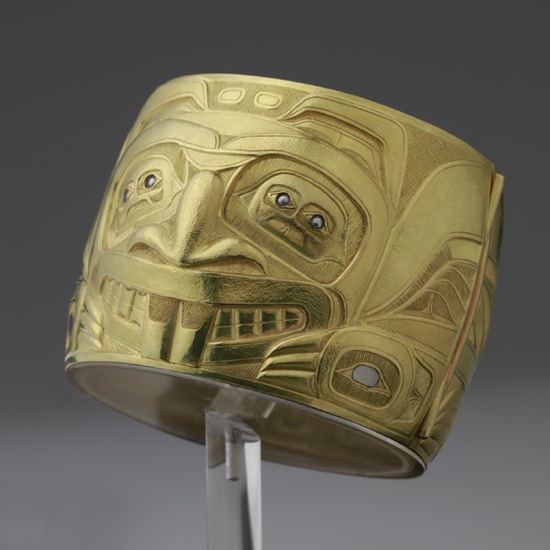
Qolun (Beaver) Bracelet; Sourced from the Coastal Peoples Fine Arts Gallery
If you happen to be strolling the cobbled streets of historic Gastown, you will come across Coastal Peoples Fine Arts Gallery (312 Water Street). The gallery, for twenty years, has been showcasing the traditional and contemporary talent of First Nations and Inuit artists and jewelers.
From now until December 18th, the Gallery is featuring a special solo exhibition that is worth visiting as you make your way down Water Street, browsing its many boutiques and specialty shops.
The exhibition entitled “Lyle Wilson, Haislakala: Spoken from the Heart” brings together the jewelry and mixed media creations of Lyle Wilson, a Hailsa (Kitamaat Village, the north coast region of BC) artist whose illustrious career includes time as the Artist in Residence at the Museum of Anthropology (MOA) and commissions for the Canadian Consulate in Osaka, Japan, and for the BC Sports Hall of Fame. His work can be found at MOA, the Vancouver International Airport, and the Royal BC Museum in Victoria.
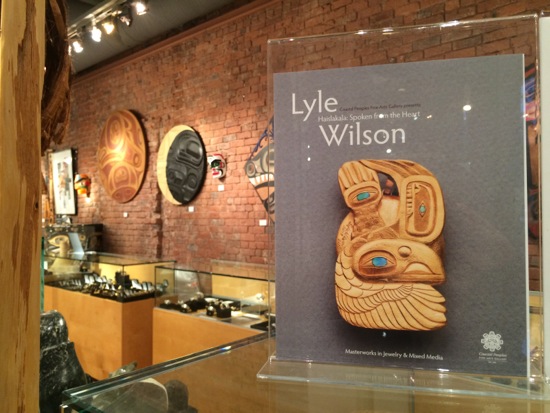
Photo Credit: Tara Lee
Visually, the curated pieces are stunning. Throughout the gallery space, you’ll find several display cases showcasing Wilson’s work, including stunning bracelets, earrings, pendants, brooches, as well as intricately carved spoons and boxes. Make sure to take the time to look at each one carefully and to read about the inspiration and stories behind them.
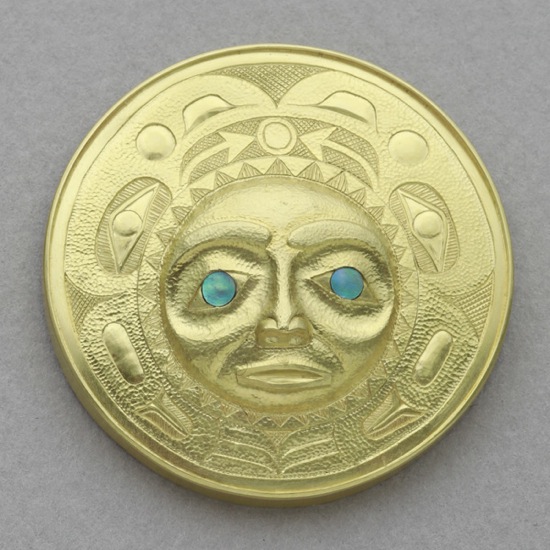
Gax & Gizawa (Raven’s Sun) Pendant; Sourced from Coastal Peoples Fine Arts Gallery
The driving force behind the work is Haislakala, the endangered traditional language of the Hailsa people. Wilson explains:
A policy of assimilation was instituted for Natives that survived earlier epidemics, and so the English language came to dominate life, trade, school and politics. My ancestors accepted that the Haislakala language was an impediment to the succeeding Haisla generations, so they never bothered to teach it to us, and we never demanded to learn it. Like many of my generation, I grew up hearing the elders speaking Haislakala, so we can recognize but not understand more than a few words. I have decided to consistently pursue learning Haislakala and include it in my life and artwork.
The pieces in the exhibition therefore are a homage to the language, storytelling, myths, symbols, and powerful cultural history tied to the Haislakala language. Creating these beautiful works were acts of remembering, as well as paying tribute in a concrete, detailed, and multi-layered way.

Miya (salmon) brooch; Sourced from Coastal Peoples Fine Arts Gallery
Wilson was particularly drawn to the clean, visually impactful look of earlier Pacific Northwest Coast (PNC) art, which he learned about from remaining works from the time. The exhibition features pieces that use more traditional Hailsa media, like wood, shell, ivory, and bone, but also silver and gold, which Wilson enjoys for their preciousness and intricate small-scale design. In short, the results are breathtaking.
For example, a box entitled Iksduq’iya & Qolu (Eagle and Beaver) is a show stopper.
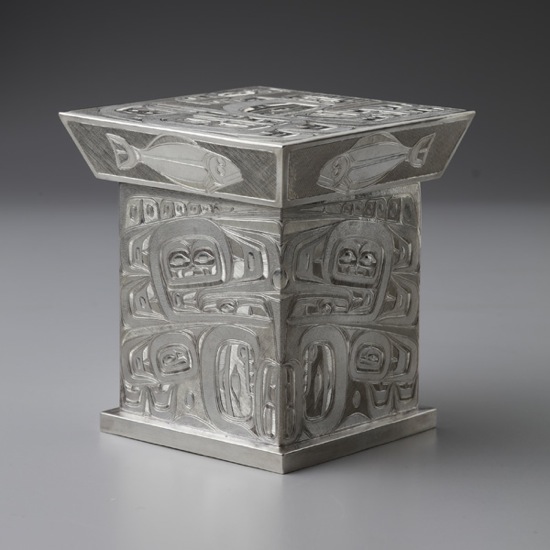
Sourced from the Coastal Peoples Fine Arts Gallery
It has beaver and eagle engravings, as a way of exploring the fact that Wilson was born into his mother’s beaver clan, but adopted by his father’s eagle one. Although, traditionally, Hailsa culture is matrilineal, the adoption occurred because the eagle clan was dying out due to disease. The box is a micro version of larger bent wooden boxes and is actually a box-within-a-box. The top of the box has an eagle engraving and a halibut carving is on the top edge.
A “Chillakoons pipe” is based on a story of three men who tossed a supernatural frog into a fire while fishing for trout.
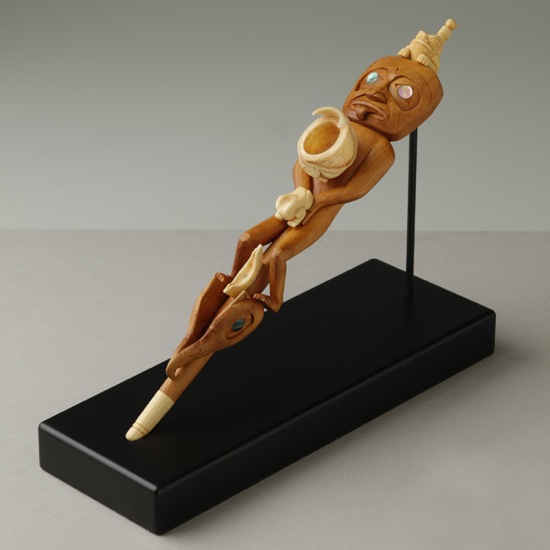
Sourced from the Coastal Peoples Fine Arts Gallery
The frog’s mother cursed them and they died as they paddled back to their village. The story was granted for use by a Haida Eagle chief as a peace offering to the Hailsa Eagle Clan. The piece, made of yew wood, yellow cedar wood, abalone, and ivory, contains a man, two frogs, a halibut, a canoe, and a cormorant head.
An “After the Ancients Bracelet” in sterling silver features the face imagery usually found on early traditional bent boxes that employed the imagery as a spiritual guardian of the precious things within them.
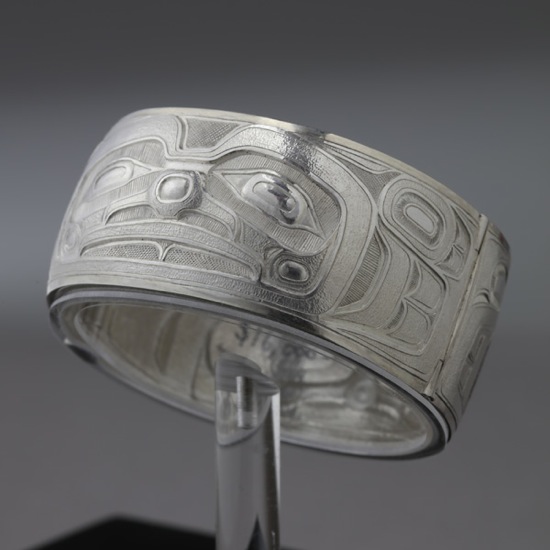
Sourced from the Coastal Peoples Fine Arts Gallery
For this piece, Wilson melds traditional PNC clean formline with modern jewelry making techniques.
All pieces are available for purchases ($400 and upwards) if you’re looking to invest in one of these works of art for a special someone (eg holiday gift giving), or for yourself.
More information about the exhibition, the individual pieces, and the gallery hours can be found on-line.













